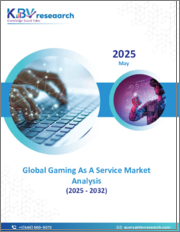
|
시장보고서
상품코드
1750783
세계의 GaaS(Gaming-as-a-Service) 시장 규모, 점유율, 동향 분석 보고서 : 플랫폼별, 게임 유형별, 수익 모델별, 최종 용도별, 지역별 및 부문별 예측(2025-2030년)Gaming As A Service Market Size, Share & Trends Analysis Report By Platform, By Game Type (Action, Adventure, Role-Playing, Simulation), By Revenue Model (Subscription, In-Game Purchases), By End Use, By Region, And Segment Forecasts, 2025 - 2030 |
||||||
세계의 GaaS(Gaming-as-a-Service) 시장 규모와 동향
세계의 GaaS(Gaming-as-a-Service) 시장 규모는 2024년 49억 1,000만 달러로 추정됐으며, 2025-2030년까지 CAGR 24.9%로 확대될 것으로 예측됩니다.
클라우드 게임의 대두는 GaaS(Gaming-as-a-Service) 시장의 중요한 촉진요인이며, 게임에 액세스하고 플레이하는 방법을 재구성하고 있습니다.
클라우드 인프라의 진보로 그래픽 격렬한 게임을 원활하게 스트리밍할 수 있어 하이엔드 하드웨어가 필요 없으며, 더 많은 사용자에 대한 액세스가 늘어나고 있습니다.
이러한 접근성 향상과 진입 장벽 감소로 참가 기업은 휴대전화, 태블릿, 스마트 TV로 AAA 게임을 즐길 수 있어 시장 확대가 가속화되고 있습니다. 그 결과 클라우드 게임은 하드웨어 제한에 관계없이 일관된 고품질 경험을 제공하는 GaaS(Gaming-as-a-Service) 모델의 핵심 요소가되고 있습니다.
게임 내 마이크로트랜잭션에 뒷받침되는 무료 플레이 게임으로의 시프트는 가장 인기 있는 시장 동향의 하나입니다. Apex Legends와 Call of Duty : Warzone과 같은 무료 플레이 타이틀의 성공은 이 모델이 지속 가능한 수익을 창출 할 수 있음을 증명합니다.
e스포츠는 토너먼트, 라이브 스트림, 조직형 대회의 비약적인 성장과 함께 시장에 필수적인 요소가 되고 있습니다. Twitch나 Youtube Gaming과 같은 플랫폼은 e스포츠를 관전하기에 최적인 공간이 되고 있으며, 게임의 지명도와 리치를 높이고 있습니다.
항상 새로운 컨텐츠와 이벤트가 업데이트되는 라이브 서비스 게임은 시장의 눈에 띄는 트렌드입니다. Fortnite나 Destiny 2와 하는 타이틀은 이 모델을 채용해, 지속적인 업데이트나 계절마다의 이벤트, 참가 기업을 장시간 열중시키는 새로운 기능을 제공합니다. 그 결과 라이브 서비스 게임은 활발한 진출기업 기반을 유지하고 정기적으로 새로운 수익 창출 전략을 도입함으로써 높은 수익성을 실현하고 있습니다.
아시아태평양의 GaaS(Gaming-as-a-Service) 산업에서는 스마트폰의 보급률이 높고 저렴한 모바일 데이터 플랜의 이용 가능성이 증가함에 따라 모바일 게임이 급증하고 있습니다. 중국에서는 PUBG Mobile이나 Honor of Kings 등의 모바일 게임이 대두해, 이 지역의 게임 수익에 크게 공헌하고 있습니다. GaaS(Gaming-as-a-Service) 산업이 계속 확대되고 있는 가운데 아시아태평양은 모바일 게임의 리더십과 기술에 익숙한 인구층 덕분에 지배적인 세력이 되는 태세를 갖추고 있습니다.
Sony는 또한 PlayStation Now와 PlayStation Plus의 서비스를 통해 GaaS(Gaming-as-a-Service) 산업에서 크게 발전하고 있습니다. Sony의 PlayStation Plus 서비스는 월별 게임 다운로드 및 제한 할인을 제공하며, 회사의 구독형 모델을 더욱 강화하고 있습니다. PlayStation Plus의 새로운 서비스가 시작됨에 따라 Sony는 진화하는 GaaS 산업에서 중요한 진출기업으로서의 역할을 더욱 견고하게 만들고 있습니다.
목차
제1장 조사 방법과 범위
제2장 주요 요약
제3장 GaaS(Gaming-as-a-Service) 시장 변수, 동향, 범위
- 시장 계통의 전망
- 시장 밸류체인 분석
- 시장 역학
- 시장 성장 촉진요인 분석
- 시장억제요인/과제분석
- 산업의 기회
- GaaS(Gaming-as-a-Service) 시장 분석 도구
- 산업 분석 - Porter's Five Forces 분석
- PESTEL 분석
- 시장 기술 동향
제4장 GaaS(Gaming-as-a-Service) 시장 : 플랫폼별, 추정 및 동향 분석
- 부문 대시보드
- GaaS(Gaming-as-a-Service) 시장 : 플랫폼 변동 분석, 2024년 및 2030년
- PC 및 노트북
- 스마트폰 및 태블릿
- 게임기
제5장 GaaS(Gaming-as-a-Service) 시장 : 게임 유형별, 추정 및 동향 분석
- 부문 대시보드
- GaaS(Gaming-as-a-Service) 시장 : 게임 유형 변동 분석, 2024년 및 2030년
- 액션
- 어드벤처
- 롤플레잉
- 시뮬레이션
- 스포츠
- 기타
제6장 GaaS(Gaming-as-a-Service) 시장 : 수익 모델별, 추정 및 동향 분석
- 부문 대시보드
- GaaS(Gaming-as-a-Service) 시장 : 수익 모델 변동 분석, 2024년 및 2030년
- 구독
- 게임내 구입
- 광고
- 기타
제7장 GaaS(Gaming-as-a-Service) 시장 : 최종 용도별, 추정 및 동향 분석
- 부문 대시보드
- GaaS(Gaming-as-a-Service) 시장 : 최종 사용자 변동 분석, 2024년 및 2030년
- 개인용
- 상용
제8장 GaaS(Gaming-as-a-Service) 시장 : 지역별, 추정 및 동향 분석
- 2024년 및 2030년 지역별 GaaS(Gaming-as-a-Service) 시장 점유율
- 북미
- 미국
- 캐나다
- 멕시코
- 유럽
- 영국
- 독일
- 프랑스
- 아시아태평양
- 중국
- 일본
- 인도
- 한국
- 호주
- 라틴아메리카
- 브라질
- 중동 및 아프리카
- 사우디아라비아
- 아랍에미리트(UAE)
- 남아프리카
제9장 경쟁 구도
- 기업 분류
- 기업의 시장 포지셔닝
- 기업 히트맵 분석
- 기업 프로파일/상장 기업
- Activision Blizzard
- Bandai Namco Entertainment
- Electronic Arts(EA)
- Epic Games
- Microsoft Corporation
- RIoT Games
- Sony Interactive Entertainment
- Square Enix
- Take-Two Interactive
- Tencent Games
- Ubisoft
- Valve Corporation
Gaming As A Service Market Size & Trends:
The global gaming as a service market size was estimated at USD 4.91 billion in 2024 and is expected to expand at a CAGR of 24.9% from 2025 to 2030. The rise of cloud gaming is a key driver in gaming as a service (GaaS) market, reshaping how games are accessed and played.
Advances in cloud infrastructure now enable seamless streaming of graphically intense games, removing the need for high-end hardware and broadening access to a larger audience. Platforms like Google Stadia and NVIDIA GeForce Now are leading this shift by offering instant game access across a range of devices with a stable internet connection.
This growing accessibility and reduced entry barriers accelerate market expansion by enabling players to enjoy AAA games on mobile phones, tablets, and smart TVs. Key drivers such as improvements in internet speed, the rollout of 5G, and advances in edge computing are enhancing streaming quality and minimizing latency. As a result, cloud gaming is becoming a central component of gaming as a service model, offering a consistent, high-quality experience regardless of hardware limitations.
The shift towards free-to-play games, supported by in-game microtransactions, is among the most popular market trends. Many developers are choosing this revenue model to attract a wide audience without the barrier of entry costs. Microtransactions, such as cosmetic items or character skins, are a steady source of income, enabling developers to update games regularly. The success of free-to-play titles like Apex Legends and Call of Duty: Warzone proves this model can create sustainable revenue. Gaming as a service industry continues to embrace microtransactions, driving innovation in in-game purchases and virtual economies.
Esports are becoming an essential part of the market, with exponential growth in tournaments, live streams, and organized competitions. Game developers are incorporating esports elements directly into their games, enhancing the competitive aspect and creating opportunities for professional play. Platforms like Twitch and YouTube Gaming are becoming the go-to spaces for watching esports, amplifying the visibility and reach of games. This integration also benefits developers, as it helps extend their games' lifecycle through sustained community engagement. The continued growth of esports within the GaaS ecosystem demonstrates the increasing professionalization and commercialization of competitive gaming.
Live service games, which are constantly updated with new content and events, are a prominent trend in the market. Titles like Fortnite and Destiny 2 have embraced this model, offering ongoing updates, seasonal events, and new features that keep players engaged for extended periods. This trend has led to games becoming more like ongoing services rather than one-time purchases, with developers using player feedback to refine the experience. As a result, live service games have become highly profitable by maintaining active player bases and regularly introducing new monetization strategies. Gaming as a service industry is evolving to prioritize long-term player engagement over short-term sales.
Gaming as a service industry in Asia Pacific is experiencing a surge in mobile gaming, driven by the high penetration of smartphones and the increasing availability of affordable mobile data plans. Countries like China, Japan, and South Korea lead the way with a massive gaming audience, and mobile-first game development is at the forefront of innovation. China has witnessed the rise of mobile games such as PUBG Mobile and Honor of Kings, contributing significantly to the region's gaming revenue. This trend has led to local developers focusing on creating mobile-optimized experiences that cater to regional tastes. As the gaming as a service industry continues to expand, Asia Pacific is poised to be a dominant force, thanks to its mobile gaming leadership and tech-savvy demographic.
Sony has also made significant strides in the gaming-as-a-service industry through its PlayStation Now and PlayStation Plus services. PlayStation Now allows gamers to stream and download a wide range of PlayStation games, making it a competitive player in the cloud gaming space. Sony's PlayStation Plus service, which offers monthly game downloads and exclusive discounts, further enhances the company's subscription-based model. With a large and loyal user base, Sony has been integrating more cloud-based features into its ecosystem, providing an all-in-one gaming service. The growth of PlayStation's subscription services and the upcoming launch of its new PlayStation Plus tiers further solidify Sony's role as a key player in the evolving gaming-as-a-service industry.
Global Gaming As A Service Market Report Segmentation
This report forecasts revenue growth at the regional and country levels and provides an analysis of the latest industry trends and opportunities in each of the sub-segments from 2018 to 2030. For this study, Grand View Research has segmented the global gaming as a service market report based on platform, game type, revenue model, end use, and region:
- Platform Outlook (Revenue, USD Million, 2018 - 2030)
- PCs and Laptops
- Smartphones and Tablets
- Gaming Consoles
- Game Type Outlook (Revenue, USD Million, 2018 - 2030)
- Action
- Adventure
- Role-Playing
- Simulation
- Strategy
- Sports
- Others
- Revenue Model Outlook (Revenue, USD Million, 2018 - 2030)
- Subscription
- In-Game Purchases
- Advertising
- Others
- End Use Outlook (Revenue, USD Million, 2018 - 2030)
- Individual
- Commercial
- Regional Outlook (Revenue, USD Million, 2018 - 2030)
- North America
- U.S.
- Canada
- Mexico
- Europe
- Germany
- UK
- France
- Asia Pacific
- China
- Japan
- India
- South Korea
- Australia
- Latin America
- Brazil
- Middle East and Africa
- Saudi Arabia
- UAE
- South Africa
Table of Contents
Chapter 1. Methodology and Scope
- 1.1. Market Segmentation and Scope
- 1.2. Market Definitions
- 1.2.1. Information analysis
- 1.2.2. Market formulation & data visualization
- 1.2.3. Data validation & publishing
- 1.3. Research Scope and Assumptions
- 1.3.1. List of Data Sources
Chapter 2. Executive Summary
- 2.1. Market Outlook
- 2.2. Segment Outlook
- 2.3. Competitive Insights
Chapter 3. Gaming as a Service Market Variables, Trends, & Scope
- 3.1. Market Lineage Outlook
- 3.2. Market Value Chain Analysis
- 3.3. Market Dynamics
- 3.3.1. Market Driver Analysis
- 3.3.2. Market Restraint/Challenge Analysis
- 3.3.3. Industry Opportunities
- 3.4. Gaming as a Service Market Analysis Tools
- 3.4.1. Industry Analysis - Porter's
- 3.4.1.1. Bargaining power of the suppliers
- 3.4.1.2. Bargaining power of the buyers
- 3.4.1.3. Threats of substitution
- 3.4.1.4. Threats from new entrants
- 3.4.1.5. Competitive rivalry
- 3.4.2. PESTEL Analysis
- 3.4.2.1. Political Landscape
- 3.4.2.2. Economic Landscape
- 3.4.2.3. Social Landscape
- 3.4.2.4. Technological Landscape
- 3.4.2.5. Environmental Landscape
- 3.4.2.6. Legal Landscape
- 3.4.1. Industry Analysis - Porter's
- 3.5. Market Technology Trends
Chapter 4. Gaming as a Service Market: Platform Estimates & Trend Analysis
- 4.1. Segment Dashboard
- 4.2. Gaming as a Service Market: Platform Movement Analysis, 2024 & 2030 (USD Million)
- 4.3. PC and Laptops
- 4.3.1. PC and Laptops Systems Market Revenue Estimates and Forecasts, 2018 - 2030 (USD Million)
- 4.4. Smartphones and Tablets
- 4.4.1. Smartphones and Tablets Market Revenue Estimates and Forecasts, 2018 - 2030 (USD Million)
- 4.5. Gaming Consoles
- 4.5.1. Gaming Consoles Market Revenue Estimates and Forecasts, 2018 - 2030 (USD Million)
Chapter 5. Gaming as a Service Market: Game Type Estimates & Trend Analysis
- 5.1. Segment Dashboard
- 5.2. Gaming as a Service Market: Game Type Movement Analysis, 2024 & 2030 (USD Million)
- 5.3. Action
- 5.3.1. Action Market Revenue Estimates and Forecasts, 2018 - 2030 (USD Million)
- 5.4. Adventure
- 5.4.1. Adventure Market Revenue Estimates and Forecasts, 2018 - 2030 (USD Million)
- 5.5. Role-Playing
- 5.5.1. Role-Playing Market Revenue Estimates and Forecasts, 2018 - 2030 (USD Million)
- 5.6. Simulation
- 5.6.1. Simulation Market Revenue Estimates and Forecasts, 2018 - 2030 (USD Million)
- 5.7. Strategy
- 5.7.1. Strategy Market Revenue Estimates and Forecasts, 2018 - 2030 (USD Million)
- 5.8. Sports
- 5.8.1. Sports Market Revenue Estimates and Forecasts, 2018 - 2030 (USD Million)
- 5.9. Others
- 5.9.1. Others Market Revenue Estimates and Forecasts, 2018 - 2030 (USD Million)
Chapter 6. Gaming as a Service Market: Revenue Model Estimates & Trend Analysis
- 6.1. Segment Dashboard
- 6.2. Gaming as a Service Market: Revenue Model Movement Analysis, 2024 & 2030 (USD Million)
- 6.3. Subscription
- 6.3.1. Subscription Market Revenue Estimates and Forecasts, 2018 - 2030 (USD Million)
- 6.4. In-Game Purchases
- 6.4.1. In-Game Purchases Market Revenue Estimates and Forecasts, 2018 - 2030 (USD Million)
- 6.5. Advertising
- 6.5.1. Advertising Market Revenue Estimates and Forecasts, 2018 - 2030 (USD Million)
- 6.6. Others
- 6.6.1. Others Market Revenue Estimates and Forecasts, 2018 - 2030 (USD Million)
Chapter 7. Gaming as a Service Market: End Use Estimates & Trend Analysis
- 7.1. Segment Dashboard
- 7.2. Gaming as a Service Market: End Use Movement Analysis, 2024 & 2030 (USD Million)
- 7.3. Individual
- 7.3.1. Individual Market Revenue Estimates and Forecasts, 2018 - 2030 (USD Million)
- 7.4. Commercial
- 7.4.1. Commercial Market Revenue Estimates and Forecasts, 2018 - 2030 (USD Million)
Chapter 8. Gaming as a Service Market: Regional Estimates & Trend Analysis
- 8.1. Gaming as a Service Market Share, By Region, 2024 & 2030 (USD Million)
- 8.2. North America
- 8.2.1. North America Gaming as a Service Market Estimates and Forecasts, 2018 - 2030 (USD Million)
- 8.2.2. U.S.
- 8.2.2.1. U.S. Gaming as a Service Market Estimates and Forecasts, 2018 - 2030 (USD Million)
- 8.2.3. Canada
- 8.2.3.1. Canada Gaming as a Service Market Estimates and Forecasts, 2018 - 2030 (USD Million)
- 8.2.4. Mexico
- 8.2.4.1. Mexico Gaming as a Service Market Estimates and Forecasts, 2018 - 2030 (USD Million)
- 8.3. Europe
- 8.3.1. Europe Gaming as a Service Market Estimates and Forecasts, 2018 - 2030 (USD Million)
- 8.3.2. UK
- 8.3.2.1. UK Gaming as a Service Market Estimates and Forecasts, 2018 - 2030 (USD Million)
- 8.3.3. Germany
- 8.3.3.1. Germany Gaming as a Service Market Estimates and Forecasts, 2018 - 2030 (USD Million)
- 8.3.4. France
- 8.3.4.1. France Gaming as a Service Market Estimates and Forecasts, 2018 - 2030 (USD Million)
- 8.4. Asia Pacific
- 8.4.1. Asia Pacific Gaming as a Service Market Estimates and Forecasts, 2018 - 2030 (USD Million)
- 8.4.2. China
- 8.4.2.1. China Gaming as a Service Market Estimates and Forecasts, 2018 - 2030 (USD Million)
- 8.4.3. Japan
- 8.4.3.1. Japan Gaming as a Service Market Estimates and Forecasts, 2018 - 2030 (USD Million)
- 8.4.4. India
- 8.4.4.1. India Gaming as a Service Market Estimates and Forecasts, 2018 - 2030 (USD Million)
- 8.4.5. South Korea
- 8.4.5.1. South Korea Gaming as a Service Market Estimates and Forecasts, 2018 - 2030 (USD Million)
- 8.4.6. Australia
- 8.4.6.1. Australia Gaming as a Service Market Estimates and Forecasts, 2018 - 2030 (USD Million)
- 8.5. Latin America
- 8.5.1. Latin America Gaming as a Service Market Estimates and Forecasts, 2018 - 2030 (USD Million)
- 8.5.2. Brazil
- 8.5.2.1. Brazil Gaming as a Service Market Estimates and Forecasts, 2018 - 2030 (USD Million)
- 8.6. Middle East and Africa
- 8.6.1. Middle East and Africa Gaming as a Service Market Estimates and Forecasts, 2018 - 2030 (USD Million)
- 8.6.2. Saudi Arabia
- 8.6.2.1. Saudi Arabia Gaming as a Service Market Estimates and Forecasts, 2018 - 2030 (USD Million)
- 8.6.3. UAE
- 8.6.3.1. UAE Gaming as a Service Market Estimates and Forecasts, 2018 - 2030 (USD Million)
- 8.6.4. South Africa
- 8.6.4.1. South Africa Gaming as a Service Market Estimates and Forecasts, 2018 - 2030 (USD Million)
Chapter 9. Competitive Landscape
- 9.1. Company Categorization
- 9.2. Company Market Positioning
- 9.3. Company Heat Map Analysis
- 9.4. Company Profiles/Listing
- 9.4.1. Activision Blizzard
- 9.4.1.1. Participant's Overview
- 9.4.1.2. Financial Performance
- 9.4.1.3. Product Benchmarking
- 9.4.1.4. Strategic Initiatives
- 9.4.2. Bandai Namco Entertainment
- 9.4.2.1. Participant's Overview
- 9.4.2.2. Financial Performance
- 9.4.2.3. Product Benchmarking
- 9.4.2.4. Strategic Initiatives
- 9.4.3. Electronic Arts (EA)
- 9.4.3.1. Participant's Overview
- 9.4.3.2. Financial Performance
- 9.4.3.3. Product Benchmarking
- 9.4.3.4. Strategic Initiatives
- 9.4.4. Epic Games
- 9.4.4.1. Participant's Overview
- 9.4.4.2. Financial Performance
- 9.4.4.3. Product Benchmarking
- 9.4.4.4. Strategic Initiatives
- 9.4.5. Microsoft Corporation
- 9.4.5.1. Participant's Overview
- 9.4.5.2. Financial Performance
- 9.4.5.3. Product Benchmarking
- 9.4.5.4. Strategic Initiatives
- 9.4.6. Riot Games
- 9.4.6.1. Participant's Overview
- 9.4.6.2. Financial Performance
- 9.4.6.3. Product Benchmarking
- 9.4.6.4. Strategic Initiatives
- 9.4.7. Sony Interactive Entertainment
- 9.4.7.1. Participant's Overview
- 9.4.7.2. Financial Performance
- 9.4.7.3. Product Benchmarking
- 9.4.7.4. Strategic Initiatives
- 9.4.8. Square Enix
- 9.4.8.1. Participant's Overview
- 9.4.8.2. Financial Performance
- 9.4.8.3. Product Benchmarking
- 9.4.8.4. Strategic Initiatives
- 9.4.9. Take-Two Interactive
- 9.4.9.1. Participant's Overview
- 9.4.9.2. Financial Performance
- 9.4.9.3. Product Benchmarking
- 9.4.9.4. Strategic Initiatives
- 9.4.10. Tencent Games
- 9.4.10.1. Participant's Overview
- 9.4.10.2. Financial Performance
- 9.4.10.3. Product Benchmarking
- 9.4.10.4. Strategic Initiatives
- 9.4.11. Ubisoft
- 9.4.11.1. Participant's Overview
- 9.4.11.2. Financial Performance
- 9.4.11.3. Product Benchmarking
- 9.4.11.4. Strategic Initiatives
- 9.4.12. Valve Corporation
- 9.4.12.1. Participant's Overview
- 9.4.12.2. Financial Performance
- 9.4.12.3. Product Benchmarking
- 9.4.12.4. Strategic Initiatives
- 9.4.1. Activision Blizzard
(주말 및 공휴일 제외)


















